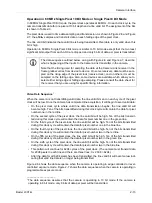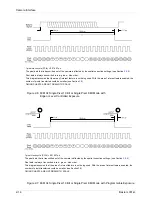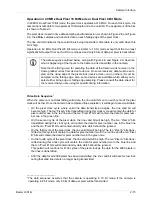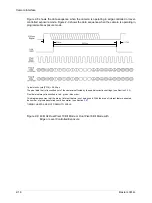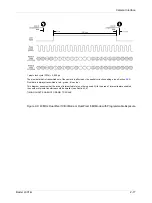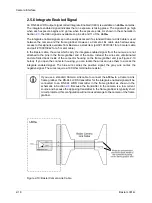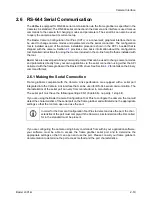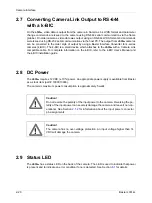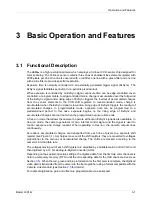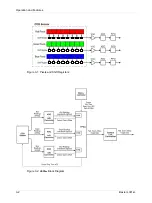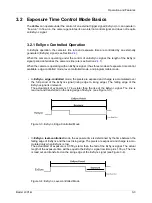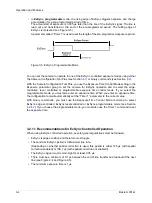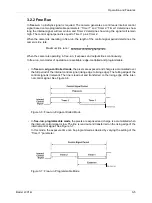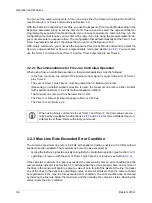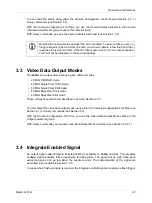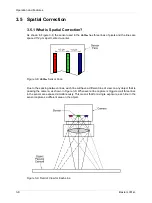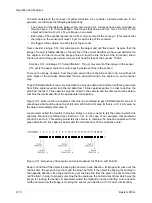
Camera Interface
Basler L301kc
2-15
DRAFT
Operation in 40 MHz Dual Pixel 10 Bit Mode or Dual Pixel 8 Bit Mode
In 40 MHz Dual Pixel 10 Bit mode, the pixel clock operates at 40 MHz. On each clock cycle, the
camera transmits data for two pixels at 10 bit depth and a line valid bit. The assignment of the bits
is shown in Table 2-3.
The pixel clock is used to time data sampling and transmission. As shown in Figure 2-8 and Figure
2-9, the
L301
kc
samples and transmits data on each falling edge of the pixel clock.
The line valid bit indicates that a valid line is being transmitted. Pixel data is only valid when this
bit is high.
Operation in 40 MHz Dual Pixel 8 Bit mode is similar to 10 bit mode except that the two least
significant bits output from each ADC are dropped and only 8 bits of data per pixel is transmitted.
Video Data Sequence
1
When the camera is not transmitting valid data, the line valid bit sent on each cycle of the pixel
clock will be low. Once the camera has completed line acquisition, it will begin to send valid data:
• On the pixel clock cycle where valid line data transmission begins, the line valid bit will
become high. The ten “Pixel A” bits transmitted during this clock cycle will contain the data for
pixel number one in the red line and the ten “Pixel B” bits will contain the data for pixel num-
ber one in the green line.
• On the second cycle of the pixel clock, the line valid bit will be high. The ten “Pixel A” bits
transmitted during this clock cycle will contain the data for pixel number one in the blue line
and the ten “Pixel B” bits will contain dummy data which should be ignored.
• On the third cycle of the pixel clock, the line valid bit will be high. The ten “Pixel A” bits trans-
mitted on this cycle will contain the data for pixel number two in the red line and the ten “Pixel
B” bits will contain the data for pixel number two in the green line.
• On the fourth cycle of the pixel clock, the line valid bit will be high. The ten “Pixel A” bits trans-
mitted during this clock cycle will contain the data for pixel number two in the blue line and
the ten “Pixel B” bits will contain dummy data which should be ignored.
This pattern will continue for 4196 cycles of the pixel clock as the data for the 2098 pixels in
the lines is transmitted.
• After the data for all 2098 pixels has been transmitted, the line valid bit will become low indi-
cating that valid line data is no longer being transmitted.
____________________
1
The data sequence assumes that the camera is operating in 10 bit mode. If the camera is
operating in 8 bit mode, only 8 bits of data per pixel will be transmitted.
L
The data sequence outlined below, along with Figure 2-8 and Figure 2-9, describe
what is happening at the inputs to the Camera Link transmitter in the camera.
Note that the timing used for sampling the data at the Camera Link receiver in the
frame grabber varies from device to device. On some receivers, data must be sam-
pled on the rising edge of the pixel clock (receive clock), and on others, it must be
sampled on the falling edge. Also, some devices are available which allow you to
select either rising edge or falling edge sampling. Please consult the data sheet for
the receiver that you are using for specific timing information.
Summary of Contents for L301kc
Page 1: ...Basler L301kc USER S MANUAL Document Number DA00051806 Release Date 13 July 2007...
Page 4: ......
Page 14: ...Introduction 1 6 Baslert L301kc DRAFT...
Page 20: ...Camera Interface 2 6 Basler L301kc DRAFT Figure 2 3 Camera Frame Grabber Interface...
Page 102: ...Configuring the Camera 4 32 Basler L301kc DRAFT...
Page 116: ...Troubleshooting 6 10 Basler L301kc DRAFT...
Page 118: ...Revision History ii Basler L301kc DRAFT...
Page 120: ...Feedback iv Basler L301kc DRAFT...
Page 124: ...Index viii Basler L301kc DRAFT...













